Storage Configuration & Testing
For our testing, the operating system is always installed to a Samsung 970 EVO NVMe based SSD. A second, identical drive is employed for testing RAID0 performance on motherboards that support this functionality natively, without PCIe adapter kits. In cases where this is necessary, an alternative is used as the OS drive. It is either an Intel SSD 750 via U.2 to PCIe adapter or a SATA based Samsung 840 Pro.
Standard SATA III 6Gb/s drive tests were performed using Western Digital Caviar Black WD1002FAEX hard drives on all SATA headers. The SATA drives were used for testing in RAID 0 64k block size configurations on all applicable controllers when possible. While not necessarily ideal, AMD controllers can’t use smaller block sizes. For an apples to apples comparison, it is necessary to choose a common block size shared by both vendor’s controllers. Additionally, third party controllers from Marvell and Realtek should support this block size as well if necessary. All drive benchmarks were done using the freely available CrystalDiskMark program, run with both 50MB and 100MB sized test sets. NVMe drives use an additional 1000MB test set.
USB 2.0 Testing
To test the capabilities of the onboard USB 2.0 connections, we used a Sans Digital external eSATA / USB 2.0 drive enclosure, connected via the USB 2.0 port. Installed in the enclosure are dual Western Digital Caviar Black WD1002FAEX drives in a RAID0 configuration. In theory, this should always saturate the USB 2.0 connection an isolate the motherboard as the biggest variable in our USB 2.0 performance tests.
USB 3.x Testing
A Thermaltake BlacX 5G docking port which uses a USB 3.x connection with a SATA based Corsair Force GT SSD installed. While not the most modern drive, it is fast enough to test the USB connection.
Motherboard Storage Configuration
These days, the chipset determines the storage configuration for the most part. The only variation tends to be with the amount of M.2 slots provisioned on a given design. The ASUS Prime X299 Edition 30 is no exception. It offers 8x SATA 6Gb/s ports and three M.2 slots. There are two 110mm long PCIe M.2 slots and one vertical slot. One of the standard slots does support both SATA and PCIe based devices. The others are PCIe only. The ASUS Prime X299 Edition 30 also offers Intel Rapid Storage Technology, Virtual RAID on CPU (vROC), and Optane memory support. All of these are standard features for an X299 Express chipset based motherboard.
50MB Test Set
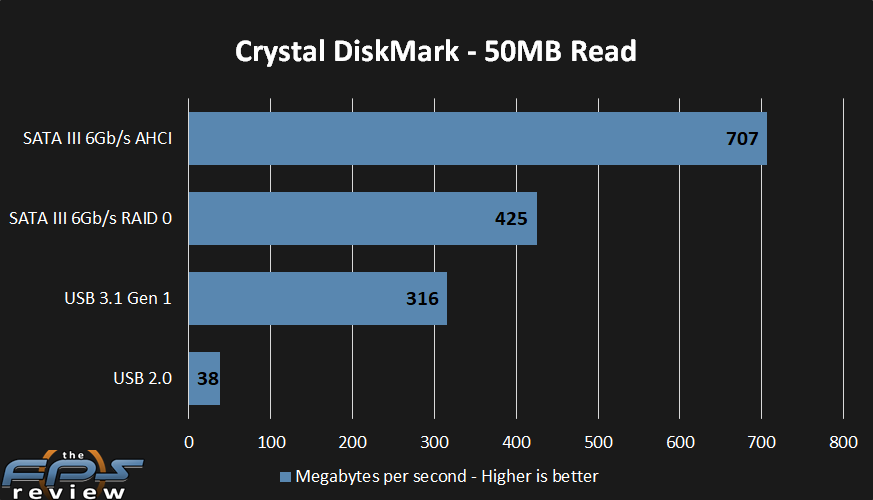
In the 50MB read test set, we saw our AHCI volume score a result of 707MB/s. The RAID 0 test fared worse, as it doesn’t typically do well in this type of workload. USB 3.1 results were somewhat on the high side, while USB 2.0 scores were right on the money in terms of what we expected.
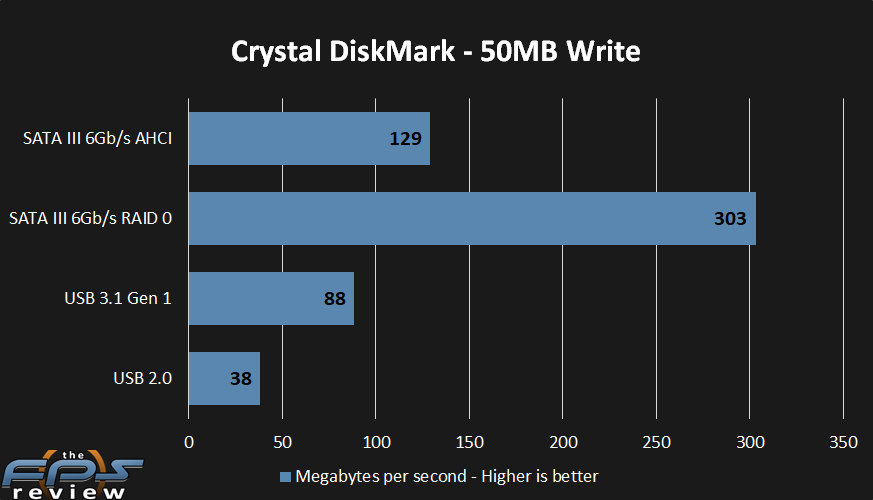
In the 50MB write test, we saw a result of 303MB/s from our RAID 0 configuration. Writes are one area where RAID 0 can improve performance, which is a stark contrast to the read test where RAID 0 hurts performance. USB results are more or less fixed by the write speed of the test device. However, we can see there are no additional bottlenecks or abnormalities with the test.
100MB Test Set
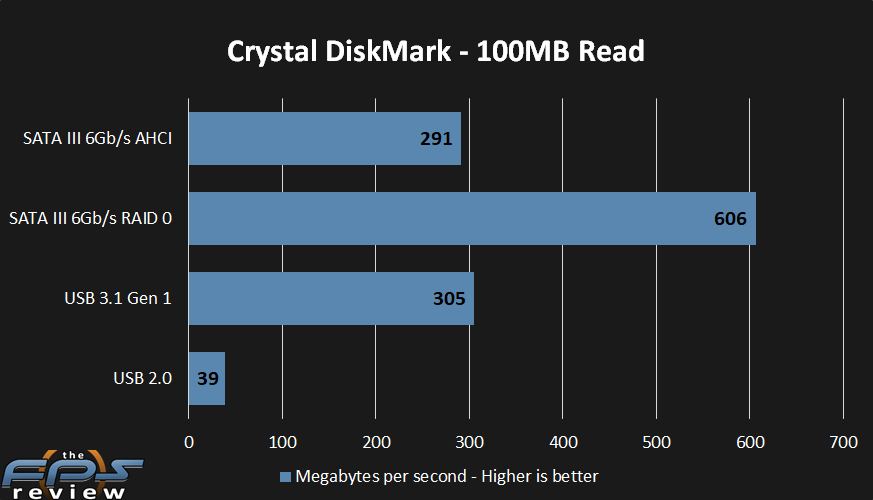
Here we can see RAID 0 finally comes into play with the larger data set and extend performance substantially. AHCI results were just under half as fast at 291MB/s compared to 606MB/s. USB 2.0 and 3.x results were what we expected coming in at 39MB/s and 305MB/s respectively.
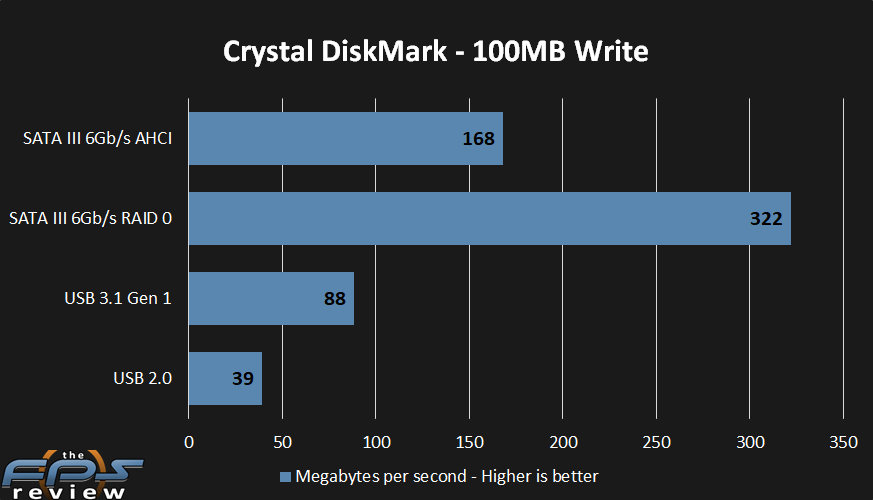
Here we can see a result of 168MB/s for the AHCI volume and 322MB/s for the RAID 0 configuration. Again, USB speeds were in the predicted range and no anomalies were encountered during testing. Performance for these storage solutions was what we would have anticipated across the board, although SATA performance, in general, was on the high side of what we’ve seen from X299 motherboards. It’s worth pointing out how inconsistent these tests can sometimes be when comparing different motherboards. However, there is still a range of results one can expect to see and the performance of the ASUS Prime X299 Edition 30 fit well within that range.
NVMe Drive Testing
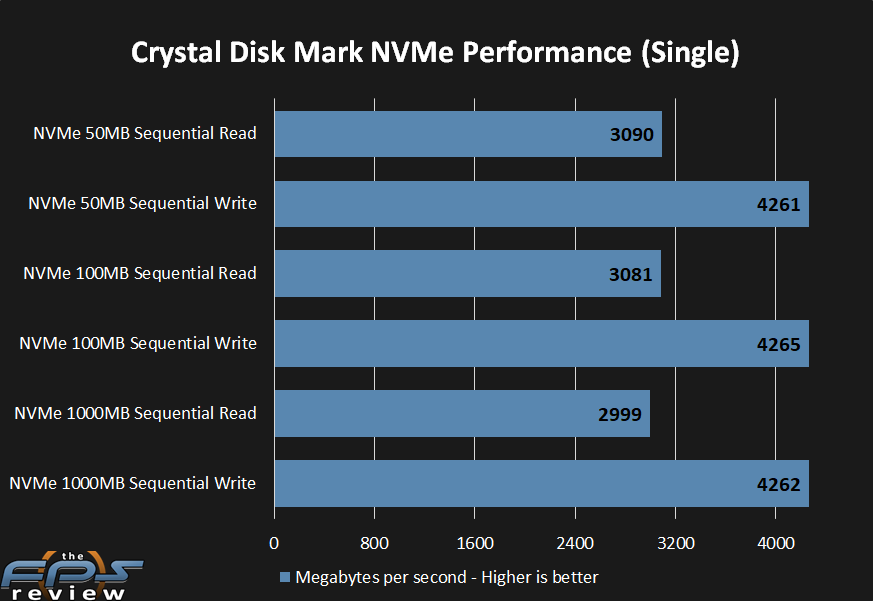
NVMe testing is a bit different than other storage testing in that the results are almost entirely dependent on the device your testing rather than the bus it is attached to. Since NVMe devices are basically PCI-Express on the back end, the drives being tested perform almost the same to the MB on every board we test them on. This case was no exception. As we often see, one of the read scores is slightly lower than the others, and while this can vary somewhat, the results are all within a very predictable for a given drive. These numbers are close to the advertised specifications for our Samsung 970 EVO NVMe drives. Moreover, these results are also nearly identical to other systems we’ve tested these drives on.
This indicates there are no bottlenecks or latency issues brought about by firmware or other variables introduced in the given motherboard design. The Prime X299 Edition 30 does offer RAID support via the PCH or via the CPU’s PCIe lanes if you have a vROC license key. I do not have such a key, so testing there isn’t possible at present. Unfortunately, I didn’t test NVMe RAID 0 performance in this case. The issue I experienced isn’t ASUS’s fault, but rather its something with Intel’s drivers. When you configure the NVMe RAID 0 array, it isn’t going to be bootable on Intel’s platform without a vROC key, or Intel’s SSD drives. This is compounded by the fact that even if you don’t want a bootable NVMe array, the RAID function is enabled and RAID drivers have to be installed for the chipset. This caused BSOD’s during the installation of the OS on a single drive. The way this was configured, was that I had three identical drives connected to the motherboard. Two were an array and one wasn’t.
AMD actually has a “RAIDable” mode where you can have a single drive which is essentially not part of an array and then install works fine. Sure, their chipset drivers and storage controllers are harder to work with, but in this instance, AMD’s solution is far better than Intel’s when it comes to more complex array configurations. A workaround for this involves installing the OS to a SATA device and retesting. However, this forces one to configure the OS and testing environment on a different type of device a second time and thus, doubles the setup time. For these reasons, NVMe RAID performance wasn’t tested here. It is worth mentioning that the motherboard does support both NVMe RAID via the PCH and the CPU, should you want to take advantage of it, but we don’t have numbers for that here.
